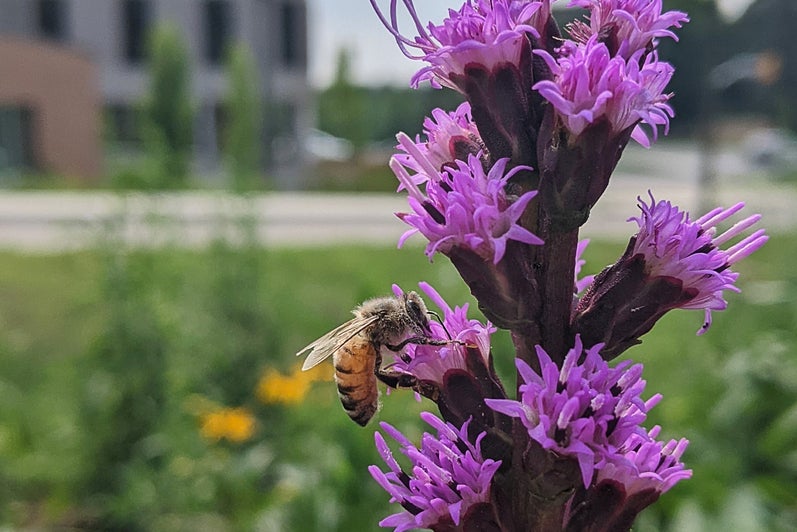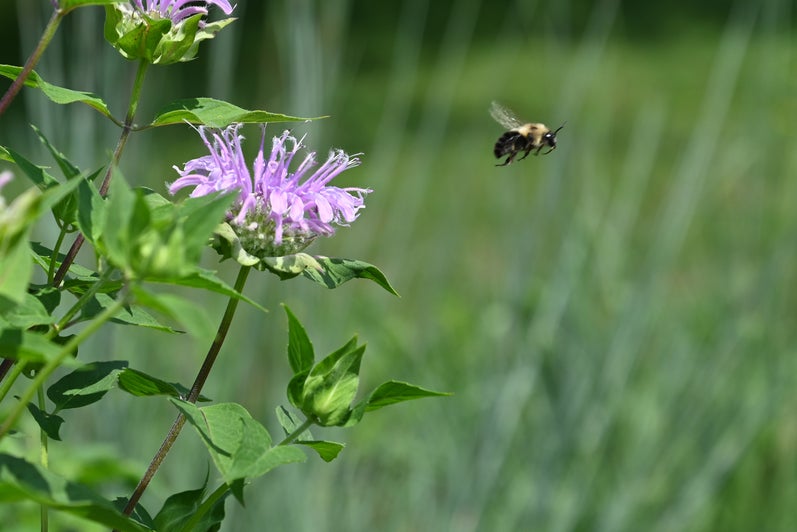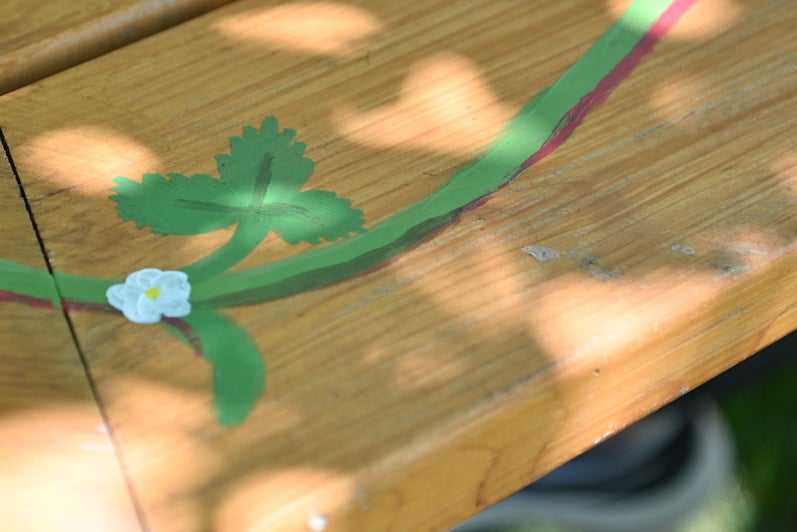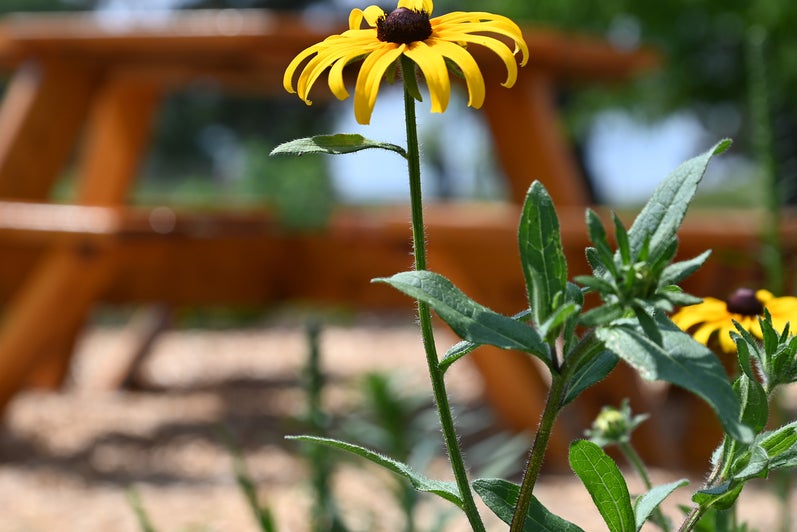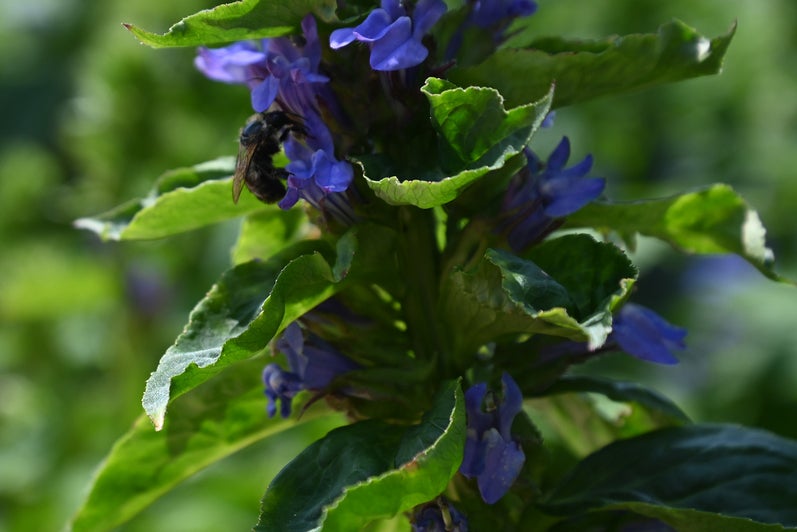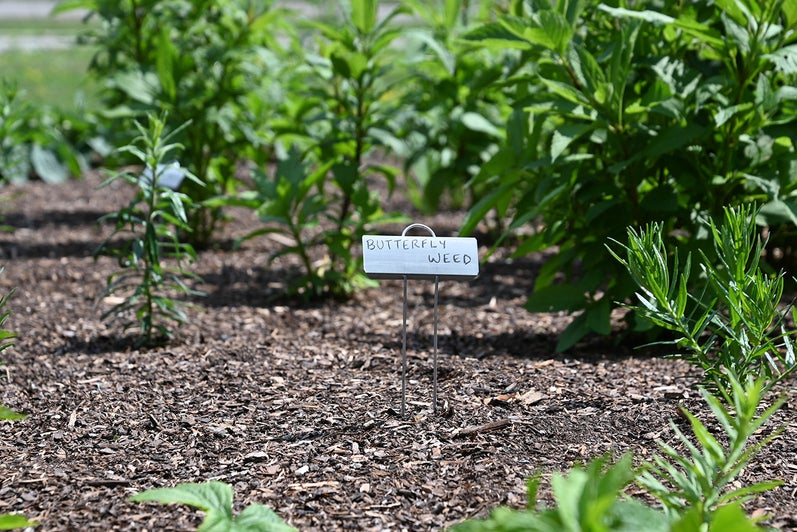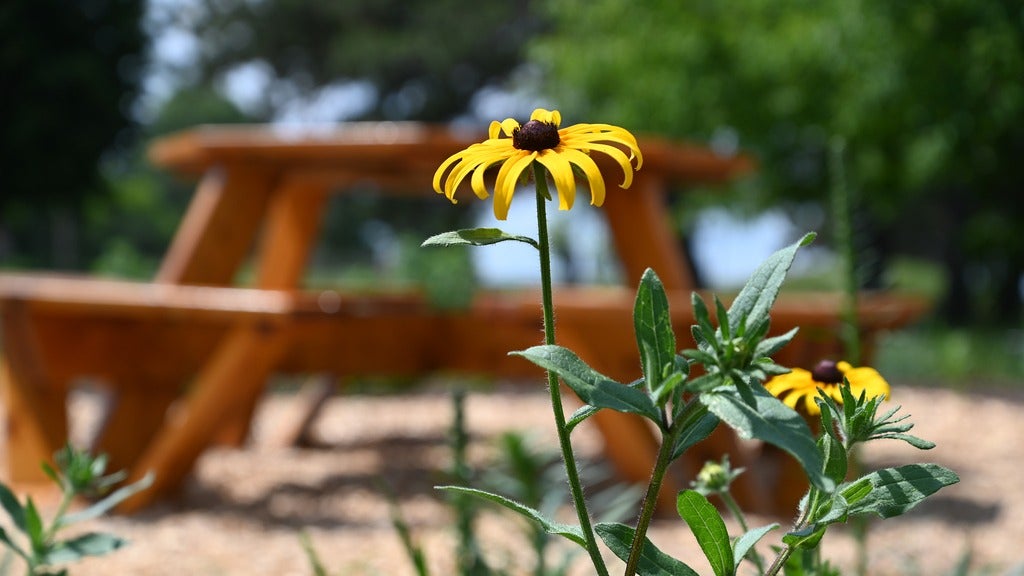
In the spring term of 2023, Grebel created a pollinator garden on the lawn outside the residence building, facing Westmount Road.
The garden contains sixteen different species of flowering native plants which provide both food and habitat for a variety of pollinating insects. Beyond attracting pollinator species, the garden is also a beautiful location for students to study, relax, or spend time with others around the 8-seater wooden table.
To learn more about the different plants in the garden, see the Plant Species drop-down table below.
Plant Species
Little Bluestem

Schizachyrium scoparium
Little bluestem is a host plant for many different species of insects, including 9 different skipper butterflies. Some insects, including female bumblebee queens, overwinter at the base of the plant to remain protected until the spring.
Photo: Northern Wildflowers.
Yellow Prairie Grass

Sorghastrum nutans
In a North American prairie ecosystem, yellow prairie grass is one of the most significant and beautiful grasses. Songbirds eat the seeds and gamefowl find shelter in the base of the grass. It is also a host plant for skipper butterflies.
Photo: Teri Knight.
Joe Pye Weed

Eutrochium
Blooms: July-September
Joe Pye weed attracts a wide variety of butterflies and bees and is a larval host for several moths. The plant has also been used in traditional Indigenous medicine for various purposes. The name of this plant may refer to a 19th-century Indigenous man named Jopi, who used the plant to cure typhus.
Butterfly Milkweed

Asclepias tuberosa
Blooms: June-August
The leaves of butterfly milkweed are a food source for monarch butterfly larvae. Many other pollinators, including the ruby-throated hummingbird, are attracted to the flowers. It has been used to treat many different ailments, especially lung diseases, by Indigenous peoples and early settlers. Therefore, the genus name Asclepias honours the Greek god of medicine, Asklepios.
Common Milkweed

Asclepias syriaca
Blooms: June-August
The leaves of common milkweed are an important food source for monarch butterfly larvae, and other insects will feed exclusively on it at different stages of life. You can wrap an elastic or string around the seed pods, and allow them to dry out on the plant in order to collect and plant them along roadsides or in your garden.
Showy Blazing Star

Liatris spicata
Blooms: July-October
Blazing star attracts many kinds of bees and butterflies, as well as hummingbirds. Indigenous peoples in North America have used blazing star roots as a pain reliever and fever treatment. The leaves were also used as an antiseptic and to treat an upset stomach. Liatris is now considered threatened in Ontario.
Purple Coneflower

Echinacea purpurea
Blooms: June-September
Purple coneflower supports a wide variety of bees and butterflies. It can be a larval host for the silvery checkerspot butterfly, sunflower moth and wavy-lined emerald moth, among others. Echinacea has powerful medicinal properties, and has been used to treat headaches, sore throats and even snake bites.
Gray-headed Coneflower

Ratibida pinnata
Blooms: June-August
Gray-headed coneflower is loved by bees, butterflies and other insects. Like purple coneflower, it is a host for caterpillars of several different moths. The center disks begin gray-coloured and turn dark brown throughout the season. A licorice scent is released when the center of the flower is rubbed!
False Sunflower

Heliopsis helianthoides
Blooms: June-August
False sunflower attracts many different types of pollinators. It is not a true sunflower, which is the genus helianthus. Holcopasites heliopis, a ground nesting cuckoo bee, is a specialist pollinator of false sunflower.
Black-eyed Susan

Rudbeckia hirta
Blooms: June-September
Black-eyed Susan attracts many different bees, butterflies and birds. Rudbeckia is a pioneer plant, meaning that it is the first to grow after a fire or natural disaster damages an area. It is also a larval host for Silvery Checkerspot, Gorgone Checkerspot and Bordered Patch butterflies.
Wild Bergamot

Monarda fistulosa
Blooms: July-August
Often called "bee balm", wild bergamot is a favourite of pollinators, and a larval host for the Hermit Sphinx moth. Both Indigenous peoples and settlers have considered this plant incredibly useful; it has been used as a medicine, fragrance, flavouring, tea, and even meat preservative!
Great Blue Lobelia

Lobelia Siphiliica
Blooms: July-September
Great blue lobelia attracts many pollinators, including bees, butterflies and hummingbirds! The tubular, lipped shape of the flower creates an easy landing pad for bees. This plant has been used by Indigenous peoples to treat coughs, nosebleeds, headaches, and even as an "anti-divorce remedy" which was secretly served to a husband and wife.
New England Aster

Symphyotrichum novae-angliae
Blooms: August-October
Asters provide an important source of nectar and pollen in the fall months. Its pollinators include bees, butterflies, flies, beetles, moths. The plant hosts pearl crescent and checkerspot caterpillars. Songbirds enjoy eating the seed heads in the winter, if the stalks are left standing. Symphyotrichum is known to have medicinal properties that aid in digestive and respiratory ailments.
Heath Aster

Symphyotrichum ericoides
Blooms: August-September
Like New England aster, heath aster blooms in late summer and fall, providing nectar and pollen after other plants have finished blooming. It hosts pearl crescent and silvery checkerspot caterpillars, as well as the wavy-lined emerald moth. Chickadees, juncos and goldfinches will pick at the seeds in winter.
Photo: Dan Mullen.
Canada Anemone

Anemone canadensis
Bloom: May-June
Anemone is taken from the Greek word anemos, meaning "wind". The plant is known to some as windflowers, perhaps due to the way they sway in a gentle breeze, or how the seeds are distributed by wind. This groundcover can spread aggressively by rhizomes, but if surrounded by taller perennials, they will co-exist well.
Photo: St. William's Nursery.
Wild Strawberry

Fragaria vesca
Bloom: April-June
Wild Strawberry is one of the first spring flowers, followed by delicious red berries. The plant carries great significance in some local Indigenous traditions.
Photo: Erik.
